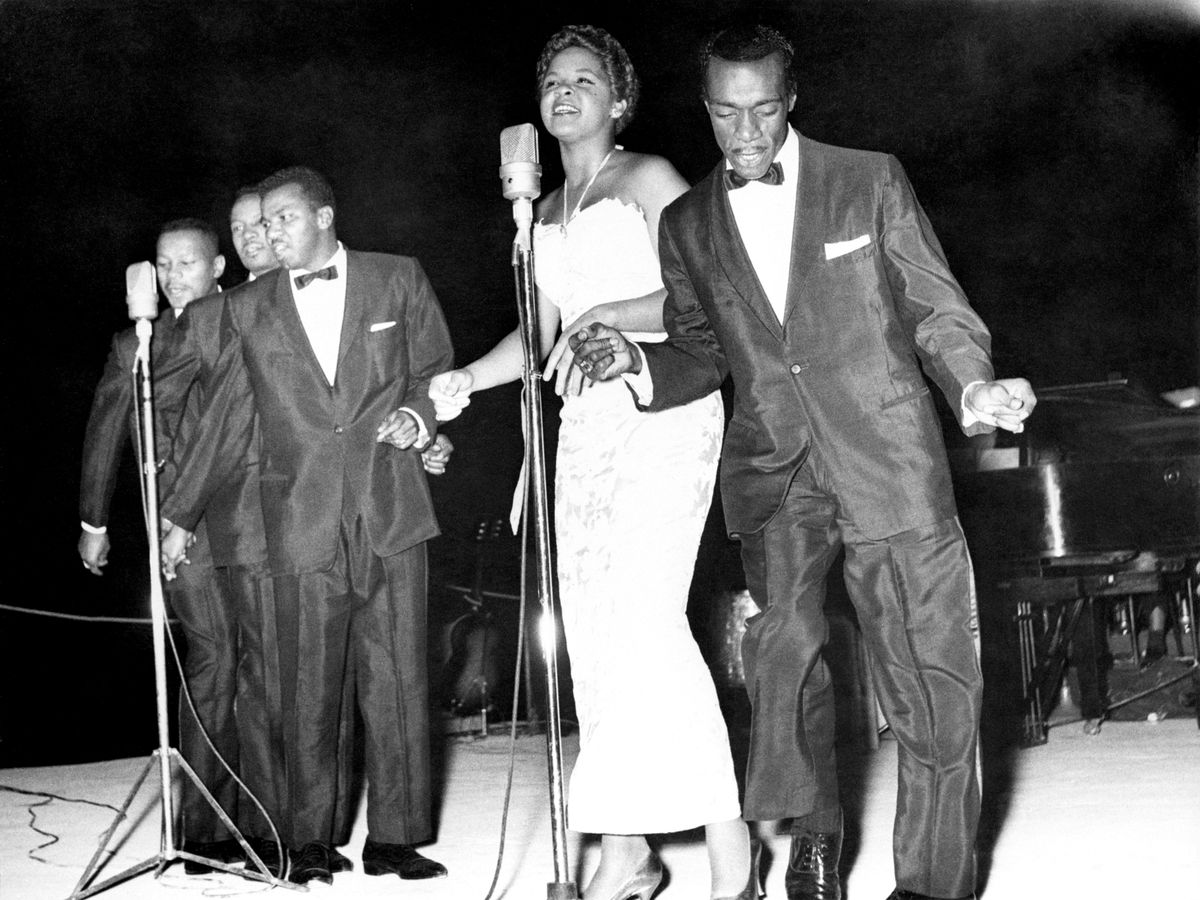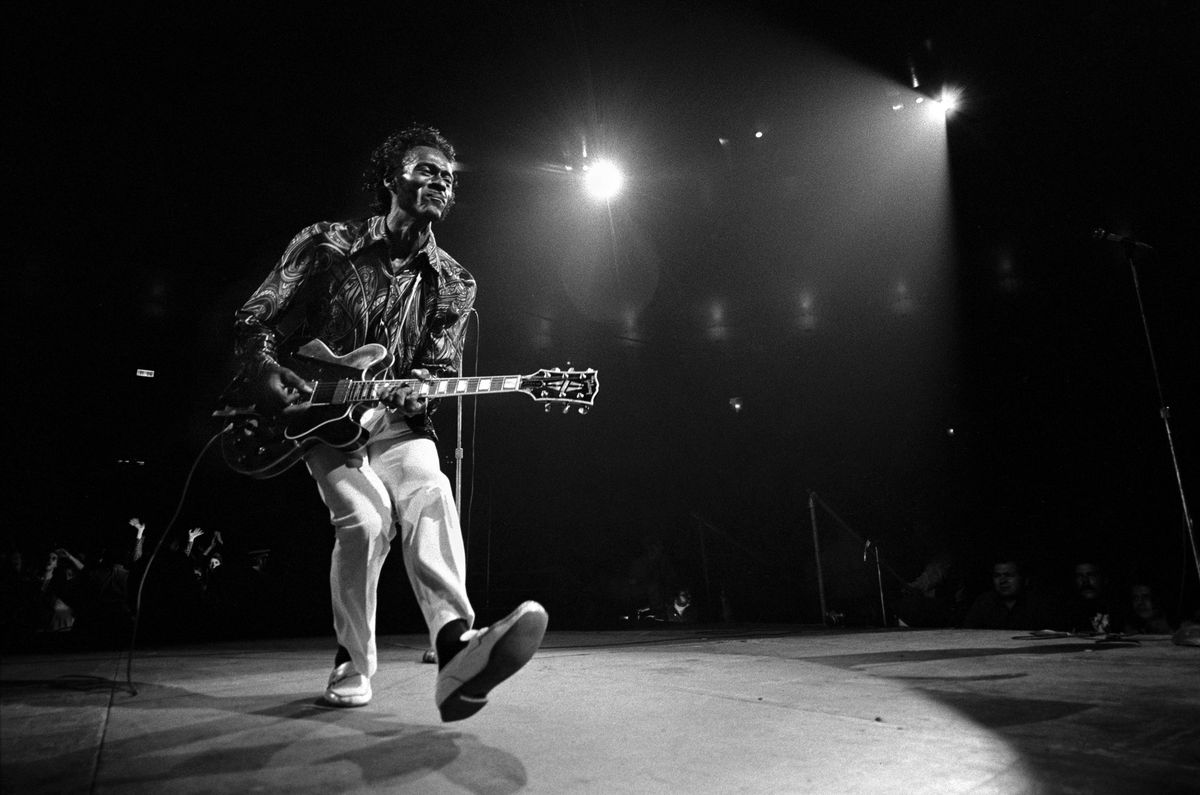Home>Genres>Rock>How Did The Popularity Of Rock And Roll Music In The 1950s Influence Society?


Rock
How Did The Popularity Of Rock And Roll Music In The 1950s Influence Society?
Published: November 22, 2023
Discover how the rise of rock and roll in the 1950s revolutionized society and shaped cultural norms, forever impacting the world through its rebellious spirit and electrifying sound.
(Many of the links in this article redirect to a specific reviewed product. Your purchase of these products through affiliate links helps to generate commission for AudioLover.com, at no extra cost. Learn more)
Table of Contents
- Introduction
- The Emergence of Rock and Roll in the 1950s
- The Impact of Rock and Roll on Youth Culture
- The Influence of Rock and Roll on Racial Integration
- Gender Roles and Rock and Roll
- Rock and Roll and the Consumer Culture
- The Rise of Teenage Rebellion
- Political and Social Controversies Surrounding Rock and Roll
- Conclusion
Introduction
Rock and roll music emerged in the 1950s and rapidly captivated the hearts and minds of young people around the world. With its energetic beats, rebellious attitude, and relatable lyrics, rock and roll became more than just a genre of music—it became a cultural force that would transform society. Its impact on various aspects of society, including youth culture, racial integration, gender roles, consumer culture, and political controversies, cannot be overstated.
In this article, we will delve into how the popularity of rock and roll music in the 1950s influenced society. We will explore the ways in which this revolutionary music genre shaped the attitudes, behaviors, and values of the younger generation while challenging societal norms and fostering social changes.
From the iconic performers like Elvis Presley, Chuck Berry, and Little Richard, to the infectious melodies and rebellious lyrics, rock and roll struck a chord with the youth of the 1950s. Its electrifying sound represented a breakaway from the traditional genres of the time, such as pop and jazz.
Throughout this article, we will examine the profound impact of rock and roll on multiple fronts. We will analyze how it influenced youth culture, breaking down racial barriers, challenging gender roles, fueling consumer culture, and even sparking political and social controversies.
Ultimately, the rise of rock and roll transformed the cultural landscape of the 1950s and set the stage for the significant social change that would unfold in the decades to come. So, let’s dive deeper into the fascinating world of rock and roll and explore how it shaped the society of its time and continues to influence us today.
The Emergence of Rock and Roll in the 1950s
In the 1950s, rock and roll emerged as a revolutionary music genre that captured the attention of a young and eager audience. It was a fusion of various musical influences, including rhythm and blues, country, and gospel music. Rooted in African American musical traditions, rock and roll brought a fresh and vibrant sound to the airwaves.
Pioneering artists like Elvis Presley, Chuck Berry, and Little Richard played a pivotal role in popularizing rock and roll. Their energetic performances, memorable tunes, and charismatic personas propelled the genre to new heights. They injected a dose of rebellion and excitement into music that had not been seen before.
The popularity of rock and roll was fueled by the emergence of new technologies like the radio and the vinyl record. This allowed the music to reach a wider audience, breaking down geographical barriers and enabling the rapid spread of the genre. The youth of the 1950s quickly embraced rock and roll as their own, using it as a form of self-expression and identity.
The lyrics of rock and roll songs often dealt with themes of teenage rebellion, love, freedom, and social issues. Songs like Elvis Presley’s “Heartbreak Hotel” and Chuck Berry’s “Johnny B. Goode” resonated with the experiences and emotions of young people, capturing the spirit of the era.
Furthermore, the emergence of rock and roll was accompanied by a visual aesthetic that further contributed to its appeal. Artists like Elvis Presley and Little Richard had unique and stylish fashion choices, becoming trendsetters for the youth of the time. Their rebellious image and charismatic stage presence added to the allure and excitement of rock and roll.
Overall, the emergence of rock and roll in the 1950s marked a turning point in music history. It challenged the status quo and injected a new sense of energy and rebellion into popular culture. The genre’s fusion of diverse musical influences created a distinct sound that resonated with the youth of the time, shaping their identities, attitudes, and cultural preferences.
The Impact of Rock and Roll on Youth Culture
Rock and roll had a profound impact on youth culture in the 1950s, fundamentally reshaping the attitudes, behaviors, and values of young people. It provided a voice for a generation eager to break free from the constraints of the past and forge their own path.
Prior to the rise of rock and roll, teenagers were largely seen as a transitional phase between childhood and adulthood, without their own distinct cultural identity. However, this changed with the advent of rock and roll. The music spoke directly to the experiences and emotions of teenagers, addressing their struggles, desires, and aspirations.
Rock and roll became a symbol of rebellion and freedom. It allowed young people to express themselves authentically and challenge the societal norms of the time. The catchy rhythms, provocative lyrics, and energetic performances of rock and roll artists resonated deeply with the teenage audience, empowering them to embrace their individuality and question authority.
Moreover, rock and roll brought about a cultural shift in terms of values and behavior. The openness and nonconformity celebrated in rock and roll music encouraged young people to embrace diversity, explore their creativity, and reject the rigid social norms imposed on them.
The influence of rock and roll extended beyond just the music itself. It permeated the fashion choices, hairstyles, and even the slang of the youth culture of the time. The rebellious and edgy style of rock and roll artists became a fashion statement, with young people emulating their idols’ looks and adopting their attitudes.
Furthermore, rock and roll played a significant role in fostering a sense of community among young people. Concerts and dance parties became social gatherings where like-minded individuals could come together, share experiences, and form lasting friendships. These events provided an outlet for young people to express themselves, connect with others, and create memories.
Overall, rock and roll revolutionized youth culture in the 1950s. It gave a voice to a generation that had long been overlooked, empowering them to embrace their own identity, challenge social norms, and shape their own futures. The impact of rock and roll on youth culture would continue to resonate for decades to come, shaping subsequent generations and influencing the cultural landscape.
The Influence of Rock and Roll on Racial Integration
Rock and roll played a significant role in breaking down racial barriers and promoting racial integration in the 1950s. The genre brought together the musical styles and influences of African American and white artists, creating a space where diverse cultures could intersect and collaborate.
Prior to the emergence of rock and roll, the music industry was segregated, with different genres catering to specific racial groups. African American artists often faced discrimination, limited opportunities, and unequal treatment. However, rock and roll challenged this systemic racism by creating a melting pot of musical styles that transcended racial boundaries.
Artists like Chuck Berry, Little Richard, and Fats Domino, who were African American, had a profound impact on popular music and helped shape the sound of rock and roll. Their talent, charisma, and innovative approach to music defied racial stereotypes and gained widespread recognition across racial lines.
Rock and roll also provided a platform for white artists to be influenced by and collaborate with African American musicians. This cross-cultural exchange not only enriched the music but also paved the way for greater social acceptance and understanding between different racial groups.
One significant example of this integration was the embrace of African American musical styles by white artists. Elvis Presley, often referred to as the “King of Rock and Roll,” drew inspiration from African American artists and incorporated their rhythms and vocal techniques into his music. This recognition and appreciation for African American culture helped to bridge the racial divide and blur the lines between musical genres.
Moreover, the widespread popularity of rock and roll among both black and white audiences led to the desegregation of concert halls, dance venues, and music festivals. Attendees of rock and roll shows were no longer divided by race but were united by their shared love for the music. This breaking down of racial barriers through music allowed for greater social interaction between different racial groups, fostering a sense of unity and breaking down long-standing prejudices.
The influence of rock and roll on racial integration in the 1950s laid the foundation for future musical movements that would continue to challenge and dismantle racial barriers. The genre paved the way for artists of all backgrounds to collaborate, allowing for a greater representation and appreciation of diverse voices and cultures in the music industry.
Gender Roles and Rock and Roll
Rock and roll had a profound impact on challenging traditional gender roles in the 1950s. The genre provided a platform for women to assert their independence, challenge societal expectations, and break free from the confines of traditional gender norms.
Prior to the emergence of rock and roll, popular music was predominantly male-dominated, with women often positioned as background singers or romantic interests. However, rock and roll created opportunities for female artists to take center stage and showcase their talent.
Artists like Wanda Jackson, Janis Joplin, and Tina Turner emerged as powerful female voices in the rock and roll scene. They defied gender norms by rocking out on stage, displaying their raw talent, and commanding the same level of respect and recognition as their male counterparts.
Rock and roll also allowed women to express their desires, independence, and assertiveness through their lyrics. Songs like “Respect” by Aretha Franklin and “Piece of My Heart” by Janis Joplin not only became anthems for women’s empowerment but also challenged the idea that women should be passive or submissive.
In addition to female artists, rock and roll had a significant impact on the way women were perceived and represented in popular culture. The rebellious and free-spirited image associated with rock and roll challenged the traditional notions of femininity and paved the way for the feminist movements of the 1960s and beyond.
Rock and roll also broke down gender barriers in terms of fashion and style. Female artists and fans adopted the bold and edgy fashion choices of rock and roll culture, which often included leather jackets, pants, and boots. This departure from traditional feminine attire challenged societal expectations of how women should dress and behave.
While rock and roll provided progressive opportunities for women in the music industry, it is important to note that gender equality was not fully realized during this time. Female artists still faced gender discrimination and unequal treatment in areas such as pay and recognition. However, the seeds of change were planted, and rock and roll set the stage for further advancements in women’s rights and gender equality.
Overall, rock and roll challenged traditional gender roles in the 1950s by empowering women to assert their independence and break free from societal expectations. The genre provided a platform for female artists to shine, allowed for the expression of female desires and assertiveness, and challenged societal norms of femininity. Rock and roll played a vital role in paving the way for greater gender equality in popular culture and beyond.
Rock and Roll and the Consumer Culture
Rock and roll had a significant impact on the consumer culture of the 1950s. The genre not only revolutionized the music industry but also sparked a wave of consumerism, as fans eagerly sought to express their identities and align themselves with the rock and roll lifestyle.
The emergence of rock and roll coincided with the rise of the teenage market as a major consumer demographic. With their newfound sense of independence and purchasing power, teenagers were eager to embrace the fashions, accessories, and products associated with rock and roll culture.
Record sales soared as fans flocked to buy the latest releases from their favorite rock and roll artists. The demand for vinyl records led to the establishment of iconic record labels and music stores, catering to the burgeoning rock and roll market.
Rock and roll also had a profound influence on fashion. The rebellious and edgy style associated with the genre, including leather jackets, jeans, and sneakers, became popular among young people. Fashion brands capitalized on the trend, producing clothing lines inspired by rock and roll aesthetics.
The connection between rock and roll and consumer culture extended beyond music and fashion. The genre became closely intertwined with other industries, such as film, television, and advertising. Rock and roll songs were featured in movies and television shows, further fueling the popularity of the music and cementing its impact on popular culture.
Furthermore, the rise of rock and roll led to the emergence of a vibrant concert culture. Fans eagerly purchased tickets to see their favorite artists perform live, contributing to the growth of the live music industry.
Merchandise sales also played a significant role in the rock and roll consumer culture. Concert-goers and fans could purchase t-shirts, posters, buttons, and other memorabilia as a way to show their support and affiliation with their favorite artists and bands.
However, it is important to acknowledge that the strong emphasis on consumerism and material possessions in the rock and roll culture of the 1950s also had its downsides. The commodification of the genre sometimes led to the watering down of its rebellious spirit and the exploitation of artists for profit.
Despite these challenges, rock and roll undeniably shaped the consumer culture of the 1950s. The genre’s influence extended well beyond the music itself, permeating various aspects of popular culture and sparking a wave of consumerism centered around rock and roll aesthetics and lifestyle.
The Rise of Teenage Rebellion
The rise of rock and roll in the 1950s coincided with a significant increase in teenage rebellion. The genre’s rebellious spirit and themes of independence, freedom, and nonconformity struck a chord with young people, inspiring them to challenge societal norms and assert their own identities.
Prior to the emergence of rock and roll, teenagers were expected to conform to the values and expectations set by their families and society. However, the energetic and rebellious nature of rock and roll provided an outlet for teenagers to express their frustrations, desires, and aspirations.
The music and lyrics of rock and roll became a rallying cry for teenage rebellion. Songs like “Rebel Rouser” by Duane Eddy and “Bad Boy” by Larry Williams embodied the spirit of youthful defiance, encouraging teens to question authority and push against the boundaries that had been placed upon them.
Rock and roll also provided an escape from the pressures of conformity and the monotony of everyday life. Through the music, teenagers found a sense of community and belonging, where they could connect with like-minded peers who felt the same sense of restlessness and desire for change.
The emergence of rock and roll also coincided with the growing influence of youth culture. Teenagers were becoming a distinct demographic with their own tastes, preferences, and desires. Rock and roll became the soundtrack of this youth culture, embodying the rebellious spirit and reflecting the experiences of the teenage years.
Beyond the music, the rock and roll lifestyle rebelled against societal norms. The fashion choices, hairstyles, and even the dances associated with rock and roll challenged traditional expectations of how teenagers should look, behave, and conform.
The rebellious nature of rock and roll was met with resistance from older generations, who saw it as a threat to societal order and moral values. The lyrics and performances of rock and roll artists were often deemed provocative and controversial, further stimulating the rebellion of teenagers against the established norms and values.
The rise of teenage rebellion in the 1950s fueled debates and concerns about the impact of rock and roll on society. Parents and authorities grappled with how to respond to this newfound sense of independence and defiance. Some sought to suppress and control rock and roll, while others recognized the importance of allowing young people the space to express themselves.
While the rebellious spirit of rock and roll did eventually evolve and shift over time, its influence on teenage rebellion in the 1950s was undeniable. The genre galvanized young people to assert their autonomy, challenge societal norms, and pave the way for the cultural shifts that would come in the following decades.
Political and Social Controversies Surrounding Rock and Roll
The rise of rock and roll in the 1950s was met with political and social controversies. The genre’s rebellious nature, provocative lyrics, and nonconformist attitudes challenged traditional values and societal norms, leading to heated debates and concerns about its impact on the youth and the broader culture.
One of the main controversies surrounding rock and roll was its perceived threat to moral standards. The provocative lyrics and suggestive performances of some rock and roll artists, such as Elvis Presley’s hip-shaking or Little Richard’s flamboyance, were seen as immoral and dangerous to the youth, often leading to calls for censorship and restrictions on the genre.
Rock and roll’s association with teenage rebellion also raised concerns about the erosion of parental authority and societal order. Older generations feared that the genre’s message of individualism and nonconformity would lead to a breakdown in social values and discipline.
The racial integration fostered by rock and roll also stirred controversy in a racially divided society. Some segments of the population resisted the idea of black and white audiences coming together, viewing it as a threat to the existing racial hierarchy and cultural traditions.
Religious institutions were also critical of rock and roll, viewing it as a corrupting influence that promoted immoral behavior and undermined religious values. Rock and roll’s associations with themes of freedom, sexuality, and rebellion clashed with conservative religious beliefs, leading to condemnation and efforts to distance the genre from religious institutions.
Furthermore, the increasing commercialization of rock and roll raised concerns about the integrity and authenticity of the genre. Some critics argued that the focus on record sales, merchandise, and image overshadowed the artistic and social significance of the music, commodifying the rebellious spirit of rock and roll.
Despite these controversies, rock and roll continued to flourish, its popularity spreading like wildfire among the youth. Promoters of the genre saw it as a form of creative expression, liberation, and a voice for social change.
Over time, as rock and roll became more mainstream and its rebellious spirit was diluted, many of the controversies subsided. The genre became accepted as an integral part of popular culture, and the influence it had on music, fashion, and social mores persisted.
Today, the controversies surrounding rock and roll in the 1950s serve as a reminder of the power of music to challenge societal norms and provoke discussions about freedom of expression, cultural shifts, and generational clashes. The genre’s ability to inspire debate and push boundaries played a significant role in shaping the cultural landscape of the time and paving the way for the music and social movements that followed.
Conclusion
The popularity of rock and roll music in the 1950s had far-reaching effects on society, leaving an indelible mark on various aspects of culture and ushering in significant social changes. The emergence of this revolutionary genre challenged the status quo, bringing forth a wave of youth culture, rebellion, and cultural integration.
Rock and roll provided a voice for a generation eager to break free from the constraints of the past and forge their own path. It resonated with young people, empowering them to express themselves authentically and question societal norms. The genre played a vital role in shaping the identities, attitudes, and behaviors of the youth, igniting a sense of rebellion and inspiring them to challenge authority.
Rock and roll also played a pivotal role in racial integration by bringing together the musical influences of African American and white artists. It challenged the segregated music industry, breaking down barriers and fostering a greater acceptance between racial groups.
Furthermore, rock and roll challenged traditional gender roles, providing a platform for female artists to shine and empowering women to assert their independence. It reshaped perceptions of femininity and inspired a generation of women to challenge societal expectations.
The consumer culture surrounding rock and roll brought forth a wave of merchandise, fashion trends, and consumerism. It changed the landscape of the music industry, encouraged the establishment of record labels, and elevated the live music experience.
Despite the controversies surrounding rock and roll, including concerns about moral values, parental authority, and commercialization, the genre persisted and left an indelible impact on popular culture. Its influence extended beyond the music itself, permeating various aspects of society and paving the way for social and cultural shifts that would follow.
In conclusion, the popularity of rock and roll music in the 1950s acted as a catalyst for social change. It transformed youth culture, promoted racial integration, challenged gender roles, and fueled consumerism. The genre’s rebellious spirit and nonconformist attitude continue to resonate today, reminding us of the power of music to shape society and inspire generations.











